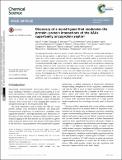Files in this item
Discovery of a novel ligand that modulates the protein-protein interactions of the AAA+ superfamily oncoprotein reptin
Item metadata
| dc.contributor.author | Healy, Alan | |
| dc.contributor.author | Houston, Douglas R. | |
| dc.contributor.author | Remnant, Lucy | |
| dc.contributor.author | Huart, Anne-Sophie | |
| dc.contributor.author | Brychtova, Veronika | |
| dc.contributor.author | Maslon, Magda M. | |
| dc.contributor.author | Meers, Olivia | |
| dc.contributor.author | Muller, Petr | |
| dc.contributor.author | Krecji, Adam | |
| dc.contributor.author | Blackburn, Elizabeth M. | |
| dc.contributor.author | Vojtesek, B. | |
| dc.contributor.author | Hernychova, Lenka | |
| dc.contributor.author | Walkinshaw, M. D. | |
| dc.contributor.author | Westwood, Nicholas James | |
| dc.contributor.author | Hupp, Ted | |
| dc.date.accessioned | 2015-04-06T15:31:02Z | |
| dc.date.available | 2015-04-06T15:31:02Z | |
| dc.date.issued | 2015 | |
| dc.identifier | 175561061 | |
| dc.identifier | 61c3dec8-73c3-48fc-a4ff-d1d3b298f8cd | |
| dc.identifier | 84928152626 | |
| dc.identifier | 000353223100055 | |
| dc.identifier.citation | Healy , A , Houston , D R , Remnant , L , Huart , A-S , Brychtova , V , Maslon , M M , Meers , O , Muller , P , Krecji , A , Blackburn , E M , Vojtesek , B , Hernychova , L , Walkinshaw , M D , Westwood , N J & Hupp , T 2015 , ' Discovery of a novel ligand that modulates the protein-protein interactions of the AAA+ superfamily oncoprotein reptin ' , Chemical Science , vol. In press . https://doi.org/10.1039/C4SC03885A | en |
| dc.identifier.issn | 2041-6520 | |
| dc.identifier.other | ORCID: /0000-0003-0630-0138/work/56424189 | |
| dc.identifier.uri | https://hdl.handle.net/10023/6436 | |
| dc.description | Financial support for this project was provided by Cancer Research UK (CRUK grant C21383/A6950). CRUK C483/A10706 and C483/A8033; EPSRC EP/F500421/1 doctoral training centre in cell and proteomic technologies; GACR P206/12/G151 and the state budget of the Czech Republic (LO1413). | en |
| dc.description.abstract | Developing approaches to discover protein-protein interactions (PPIs) remains a fundamental challenge. A chemical biology platform is applied here to identify novel PPIs for the AAA+ superfamily oncoprotein reptin. An in silico screen coupled with chemical optimization provided Liddean, a nucleotide-mimetic which modulates reptin’s oligomerization status, protein-binding activity and global conformation. Combinatorial peptide phage library screening of Liddean-bound reptin with next generation sequencing identified interaction motifs including a novel reptin docking site on the p53 tumor suppressor protein. Proximity ligation assays demonstrated that endogenous reptin forms a predominantly cytoplasmic complex with its paralog pontin in cancer cells and Liddean promotes a shift of this complex to the nucleus. An emerging view of PPIs in higher eukaryotes is that they occur through a striking diversity of linear peptide motifs. The discovery of a compound that alters reptin’s protein interaction landscape potentially leads to novel avenues for therapeutic development. | |
| dc.format.extent | 1047570 | |
| dc.language.iso | eng | |
| dc.relation.ispartof | Chemical Science | en |
| dc.subject | QD Chemistry | en |
| dc.subject | NDAS | en |
| dc.subject | SDG 3 - Good Health and Well-being | en |
| dc.subject.lcc | QD | en |
| dc.title | Discovery of a novel ligand that modulates the protein-protein interactions of the AAA+ superfamily oncoprotein reptin | en |
| dc.type | Journal article | en |
| dc.contributor.sponsor | Cancer Research UK | en |
| dc.contributor.institution | University of St Andrews. School of Chemistry | en |
| dc.contributor.institution | University of St Andrews. EaSTCHEM | en |
| dc.contributor.institution | University of St Andrews. Biomedical Sciences Research Complex | en |
| dc.identifier.doi | 10.1039/C4SC03885A | |
| dc.description.status | Peer reviewed | en |
| dc.identifier.grantnumber | N/A | en |
This item appears in the following Collection(s)
Items in the St Andrews Research Repository are protected by copyright, with all rights reserved, unless otherwise indicated.

